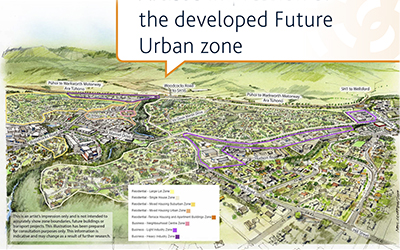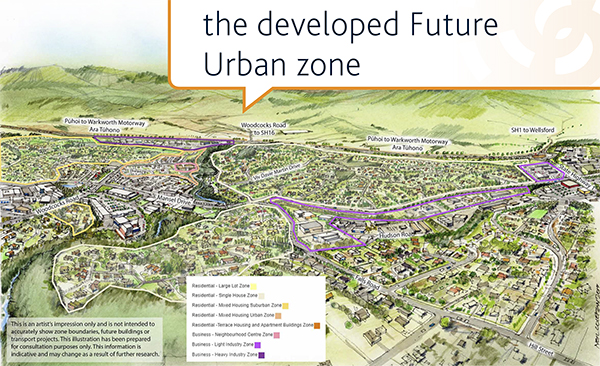Strikingly unfit for fossil-fuel-free future


Single-House Zoning: Dominating this artist’s impression of Auckland Council’s draft structure plan are single-house zones that will lock in car dependency, right at the time ‘even’ school children appreciate the need for active- and public-transport-savvy planning, and are striking for a far more adult response. rendering Auckland Council
Anthropogenic climate disruption is not just another issue. It is the issue that will bedevil generation after generation for at least hundreds of years.
Just how hard and how fast global warming will impact cannot be accurately quantified, given that carbon dioxide levels have not been raised this rapidly before100 to 200 times faster than during the transition from the last ice age and, equally importantly, the response—whether humanity mobilises or continues business-as-usual—is yet to be discerned.
If school students stick to their strikes, governments will be forced to begin meaningful climate action. Seven months after Greta Thunberg began her—initially every-school-day, then every Friday—strike, more than 1.4 million joined her, on 15 March. Vested interests will be hoping it will fizzle as fast as the likes of the 59-day occupation of Wall Street. But anyone with an ounce of compassion for the generations born into an increasingly uninhabitable Earth should pray that today’s school students yet prove to be less self-absorbed than cohorts Baby Boomer through Generation z.
That the world is woefully ill-prepared for climate-turmoil was already writ large in Europe when a mere million Syrian refugees fueled the hate-filled ascendency of all manner of white supremacist political parties, epitomised by the 22 July massacre in Norway, 2011—and copycat killings, just the latest being 15 March, Christchurch. That a million refugeesof a total of 5,165,502 registered refugees, as of August 2017 could destabilise a population of 741 million is an indication of the unprecedented challenge that climate refugees will increasingly pose. With sea-level rise already in the pipeline set to inundate almost the entirety of Bangladesh, how many of its more than 167 million will be forced into densely populated neighbouring countries, and how soon, can only begin to be anticipated—and the repercussions, the stuff of nightmares.
With its preponderance of detached single-house zoning, signalling an earthmover-scrapped, steel-reinforced-concrete-slab smothered landscape, the draft structure plan will help perpetrate the same-old-same-old development style with its unconscionably high carbon footprint, both during construction and its subsequent car-dependency—to be remotely fit-for-purpose, the new Warkworth must, first and foremost, be walkable, and richly walkable, not just walkable at a pinch.
Warkworth Structure Plan submission
As submitted by midnight 25 March 2019 by Mahurangi Action and by various Mahurangi Magazine readersbecause the pro forma was developed over time, feedback submitted during the days leading up to the deadline contained correspondingly fewer sections.
Vision for Warkworth Structure Plan
Warkworth is a satellite town that retains its natural character, and establishes a clear, inviolate ‘wall’ beyond which it will never encroach upon the adjacent rural. Embracing the Mahurangi River, the tidehead town is palpably connected with the Mahurangi Harbour and the Hauraki Gulf. The river is the strong backbone of rich network of linear parks, paths and cycleways, providing active access throughout the town. Warkworth is compact and surprisingly self-sufficient with plenty of employment, education, shopping and recreation opportunities. Mindful of the existential imperative to rapidly become fossil-fuel-free, Warkworth is the least car-centric country town in Aotearoa.
Green network
A Mahurangi River-based green network is indeed the robust scaffold on which the Warkworth Structure Plan should properly be built. However, a 10-metre stream margin should be considered the minimum to create broad corridors for people, paths and cycling, and for biodiversity. Broader margins could include appropriate development, from canoe hire to cafés. While the additional protection for the Warkworth town basin’s forest backdrop is noted, this should be extended upriver to the skimpy margin immediately opposite the town centre. If the structure plan is designed for an appropriate density, there will be ample area available for a rich, Mahurangi River-based green network.
Single-house preponderance
While the Draft Warkworth Structure Plan mentions climate in 10 places, nowhere does it address development-phase emissions. The default development style involves large-scale earthmoving and heavy use of asphalt for road-making, and steel-reinforced concrete for the floors of buildings. The preponderance of single-house zoning in the draft structure plan would reinforce this old-dated high-carbon-impact development style. What is already overdue is more compact accommodation, built of durable low-emission materials. Wood, with sound design and factory-built construction methods, positively sequesters carbon. Compact development forms allow the broader riparian corridors needed for the Green Network.
Affordability
Appropriately, the draft structure plan discusses the acute regional issue of affordability. However, the preponderance of single-house zoning overall, and particularly in the first, Warkworth North, area to be actively zoned, is not consistent with the need to urgently address accommodation affordability. Affordability is pivotal to Warkworth remaining viable for its current major employers, without the bulk of workers being obliged to commute from Wellsford or Helensville. It is also critical in the context of accommodating refugees, with which New Zealand drags its heels internationally.
